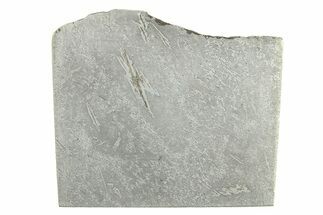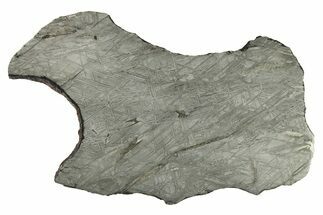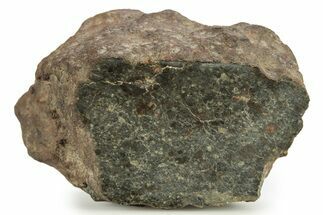This Specimen has been sold.
1.93" Balambala Iron Meteorite Slice (37.5 g) - Rare IIF Iron
This is a 1.93" wide (37.5 gram), etched slice of the Balambala meteorite, a very rare IIF iron classification. The slice has been etched and comes with a floating frame display case.
About The Balambala Meteorite - Rare IIF Iron
Balambala is the name given to a rare IIF iron meteorite--only one of seven ever given this classification!--found in eastern Kenya in 2018. It was known to locals in the area for decades and called "Dhagax Bir", meaning metal stone in the local Somali dialect. A nomad eventually identified it as a meteorite in 2018 and brought it to a broker in Garissa. From there it was purchased and subsequently sliced and disseminated for collections.
Balambala is a roughly 61-kilogram, shield-shaped mass with extensive regmaglypts and minor rusting on its exterior but no other signs of oxidation. It is a IIF iron, a rare classification of iron meteorite characterized by high nickel contents and high concentrations of metals such as gallium, germanium, copper, and cobalt. Their compositions match closely with planetesimal cores, and they could likely be from the same parent body as the Eagle Station Pallasites, which have similar metal compositions. It often contains rounded troilite inclusions when sliced, with small spindles of kamacite surrounding schriebersite in a largely taenite matrix. Because of its high nickel content, it does not contain Widmanstätten lines outside of the errant kamacite crystals.
Balambala is the name given to a rare IIF iron meteorite--only one of seven ever given this classification!--found in eastern Kenya in 2018. It was known to locals in the area for decades and called "Dhagax Bir", meaning metal stone in the local Somali dialect. A nomad eventually identified it as a meteorite in 2018 and brought it to a broker in Garissa. From there it was purchased and subsequently sliced and disseminated for collections.
Balambala is a roughly 61-kilogram, shield-shaped mass with extensive regmaglypts and minor rusting on its exterior but no other signs of oxidation. It is a IIF iron, a rare classification of iron meteorite characterized by high nickel contents and high concentrations of metals such as gallium, germanium, copper, and cobalt. Their compositions match closely with planetesimal cores, and they could likely be from the same parent body as the Eagle Station Pallasites, which have similar metal compositions. It often contains rounded troilite inclusions when sliced, with small spindles of kamacite surrounding schriebersite in a largely taenite matrix. Because of its high nickel content, it does not contain Widmanstätten lines outside of the errant kamacite crystals.
About Iron Meteorites
Iron type meteorites are composed primarily of iron and nickel, and are the remnants of differential cores torn apart at the beginning of the solar system. These metallic meteorites are often the easiest to identify after millions of years post-impact because they are quite different from terrestrial material, especially when it comes to their mass-to-surface area ratio. They are exceptionally heavy for their size since iron is a high-density metal: this is also why the Earth's core is nickel-iron. As planets form, the densest metals form gravitational centers, bringing more and more material into their gravitational pull. In the solar system's rocky planets, these dense materials are most often nickel and iron.
Most iron meteorites have distinctive, geometric patterns called Widmanstätten patterns, which become visible when the meteorite is cut and acid etched. These patterns are criss-crossing bands of the iron-nickel alloys kamacite and taenite that slowly crystalized as the core of the meteorites' parent bodies slowly cooled. Such large alloy crystallizations for mover millions of years and do not occur naturally on Earth, further proving that iron meteorites come from extraterrestrial bodies.
Iron type meteorites are composed primarily of iron and nickel, and are the remnants of differential cores torn apart at the beginning of the solar system. These metallic meteorites are often the easiest to identify after millions of years post-impact because they are quite different from terrestrial material, especially when it comes to their mass-to-surface area ratio. They are exceptionally heavy for their size since iron is a high-density metal: this is also why the Earth's core is nickel-iron. As planets form, the densest metals form gravitational centers, bringing more and more material into their gravitational pull. In the solar system's rocky planets, these dense materials are most often nickel and iron.
Most iron meteorites have distinctive, geometric patterns called Widmanstätten patterns, which become visible when the meteorite is cut and acid etched. These patterns are criss-crossing bands of the iron-nickel alloys kamacite and taenite that slowly crystalized as the core of the meteorites' parent bodies slowly cooled. Such large alloy crystallizations for mover millions of years and do not occur naturally on Earth, further proving that iron meteorites come from extraterrestrial bodies.
TYPE
Iron (IIF)
AGE
LOCATION
Northeastern Kenya
SIZE
1.93 x 1.15", .15" thick, Weight: 37.5 grams
CATEGORY
SUB CATEGORY
ITEM
#284617
 Reviews
Reviews












